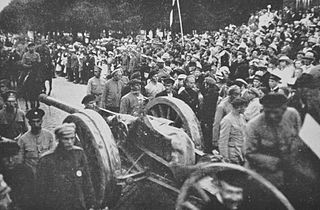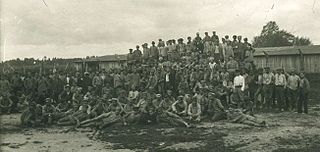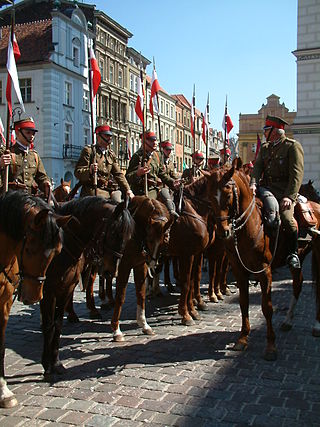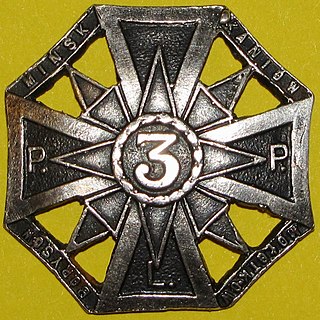
List of battles of the Polish-Soviet War by chronology:
- Battles for Vilnius (1918–1919) (31 December 1918 – 5 January 1919)
- Soviet "Target Vistula" offensive (January–February 1919)
- Battle of Bereza Kartuska (9 February 1919: the first battle of the conflict)
- Battle of Pinsk (23 February – 5 March 1919)
- Battle of Byteń (February – March 1919)
- Battle of Barbarów (5 March 1919)
- Battle of Gawinowicze (8 March 1919)
- Battle of Hłybow (8 March 1919)
- First Battle of Baranowicze (13–15 March 1919 and 13–19 April 1919)
- Nieśwież uprising (14–19 March 1919)
- Vilna offensive: Polish offensive to Vilna (April 1919)
- First Battle of Lida (16-17 April 1919)
- Battle of Stołowicze (1919) (16–19 April 1919)
- Battle of Nowogródek (18 April 1919)
- Battle of Staryki and Czernica (20 April 1919)
- Battle of Święciany (1919) (13–14 May 1919)
- Battle of Berezina (1919)
- Battle of Rafałówka (June 1919)
- Battle of Pastavy (1919) (19 June – 21 June, 1919)
- Battle of Treszczyna (July 1919)
- Operation Minsk: Polish offensive to Minsk (July–August 1919)
- Battles of Chorupań and Dubno (19 July 1919)
- Battle of Olszany (2 August 1919)
- Battle of Małe Gajany (7 August 1919)
- Battle of Sloboda (8–9 August 1919)
- Battle of Daugavpils (1919) (20 August – 29 September 1919)
- Battle of Polotsk (1919) (21 September – 4 November 1919)
- Battle of Ziabki (1919) (22 August 1919)
- Battle of the Daugava (1920) (29 August 1919 – January 1920)
- Battle of Lepel (1919) (29 September 1919 – 5 November 1919, 13–16 November 1919)
- Battle of Luboniczary (2 October 1919)
- Battle of Kobylszczyzna (17 October 1919)
- Battle of Kliczew (12-14 December 1919)
- Battle of Sieliszcze (13–14 December 1919)
- Battle of Dąbrowica (28 November 1919)
- Battle of Romanów (23 December 1919)
- Battle of Nowosiółki (28 December 1919)
- Battle of Śnicka (January 1920)
- Battle of Daugavpils - Joint Polish-Latvian operation (3 January 1920)
- Battle of Pawłówka (22 January 1920)
- Battle of Poliszczyn (23 January – 3 February 1920)
- Battle of Itol (24 January 1920)
- Battle of Kuźnicze (30 January 1920)
- Battle of Borkowicze (5 February 1920)
- First Battle of Ovruch (10–12 January 1920)
- Battle of Stodolicz (16–17 February 1920)
- Battle of Latyczów (18-22 February 1920)
- Battle of Łuczanki (21 February 1920)
- Battle of Kazimierzówka (24 February 1920)
- Battle of Kalinkowicze (March – June 1920)
- Battle of Mazyr and Kalenkowicze (4–6 March 1920)
- Second Battle of Ovruch (7 March 1920)
- Battle of Borowiki (17 March 1920 - April 4, 1920)
- Battle of Wołkowińce (17 March 1920; 14 April 1920)
- Battle of Stepanovka (19 March 1920)
- Battle of Zwiahl (21 March 1920)
- Battle of Jełan (4 – 5 April 1920, 3 May 1920, 7 May 1920)
- Battle of Svietlahorsk (9–22 April 1920)
- Battle of Strużka (11 April 1920)
- Battle of Koziatyn (25–27 April 1920)
- Battle of Czarnobyl (27 April 1920)
- Battle of the Berezina (1920) (15 May 1920)
- Kiev offensive (May–June 1920)
- Battle of Wołodarka (29 May 1920)
- Battle of Bystryk (31 May 1920)
- Battle of Boryspil (2 June 1920)
- Battle of Borodzianka (11-13 June 1920)
- Battle of Głębokie (4-6 July 1920)
- Battle of Barysaw (August - October 1919)
- Battle of Mironówka
- Battle of Olszanica
- Battle of Żywotów
- Battle of Miedwiedówka
- Battle of Dziunków
- Battle of Wasylkowce
- Battle of Grodno (19-20 July 1920)
- Battle of Brody and Berestechko (29 July – 3 August 1920)
- Battle of Serock
- Battle of Ostrołęka (2-6 August 1920)
- Battle of Lwów (July–September 1920)
- Battle of Tarnopol (31 July - 6 August 1920)
- Battle of Warsaw (15 August 1920)
- Battle of Nasielsk, Battle of Radzymin, Battle of Ossów, Battle of Borkowo, Battle of Kock (14–15 August 1920)
- Battle of Cyców (15–16 August 1920)
- Battle of Dęblin and Mińsk Mazowiecki (16–18 August 1920)
- Battle of Zadwórze: the "Polish Thermopylæ" (17 August 1920)
- Battle of Przasnysz (21–22 August 1920)
- Battle of Sarnowa Góra (21–22 August 1920)
- Battle of Białystok (22 August 1920)
- Battle of Zamość (29 August 1920)
- Battle of Komarów (31 August 1920)
- Battle of Hrubieszów (1 September 1920)
- Battle of Sejny (September 1920)
- Battle of Kobryń (1920) (14–15 September 1920)
- Battle of Dytiatyn (16 September 1920)
- Battle of Brzostowica (20 September 1920)
- Battle of the Niemen River (September 26–28, 1920)
- Battles of Obuchowe and Krwawy Bór (27–28 September 1920)
- Battle of Zboiska
- Battle of Minsk (1920) (18 October 1920)

















